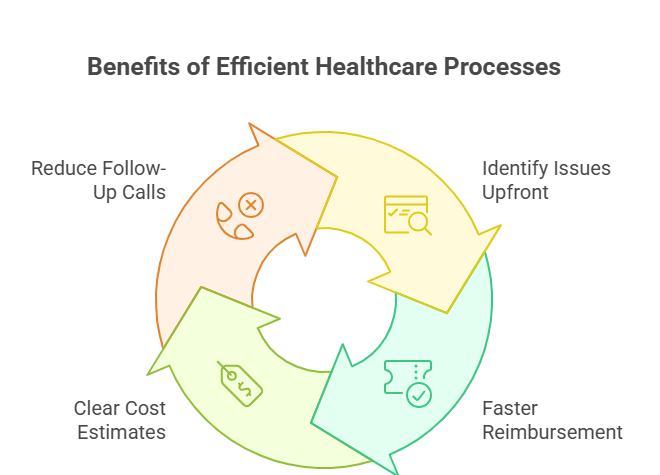On-Demand Outsourcing BPO Services for Healthcare Providers With 24/7 Coverage!
Save up to 70% on staffing costs!
Browse Specialty Staffing ServicesUnderstanding the Insurance Verification Workflow in Healthcare Settings

It’s Monday morning at Riverbend Family Clinic. Maria, the front desk coordinator, logs in to her system. Her Virtual Insurance Verification Assistant has already confirmed coverage for the day’s scheduled patients, flagged a few eligibility issues, and prepared pre-authorization requests for procedures.
When patients arrive, check-ins are smooth—no surprise denials or billing disputes. Providers can focus on care, while Maria confidently explains benefits and collects accurate co-pays.
This isn’t a dream scenario—it’s how optimized insurance verification workflows are transforming healthcare administration.
The Great Shift: From Reactive Billing to Proactive Verification
Historically, insurance verification was reactive—handled post-visit, often leading to delayed payments, claim denials, and frustrated patients. In today’s fast-paced healthcare environment, proactive insurance verification has become mission-critical to ensure seamless care and revenue cycle efficiency.
By integrating trained virtual assistants and automated tools, clinics can confirm coverage upfront, prevent denials, and accelerate cash flow.
What Is Insurance Verification in Healthcare?
Insurance verification is the process of confirming a patient’s coverage, benefits, and eligibility details before care is delivered. This involves checking:
• Active coverage status
• Copays, coinsurance, and deductibles
• Pre-authorization or referral requirements
• Plan limitations or exclusions
Why It Matters: The Impact of Accurate Verification
A strong insurance verification workflow benefits both providers and patients:

• Reduced claim denials: Identify issues upfront to prevent rework.
• Improved revenue cycle: Faster reimbursement with fewer rejections.
• Enhanced patient experience: Clear cost estimates and no surprise bills.
• Operational efficiency: Front-office teams spend less time on follow-up calls and appeals.
Key Steps in the Insurance Verification Workflow
Collect Accurate Patient Information: Obtain insurance cards, demographics, and policy details.
Verify Eligibility: Confirm coverage using payer portals, clearinghouses, or automated tools.
Determine Benefits: Review copay, coinsurance, deductible, and plan limitations.
Check Pre-Authorization Requirements: Initiate prior approvals when needed.
Communicate Costs to Patients: Provide upfront estimates and collect applicable fees.
Document Everything: Record verification details in the EHR and billing systems.
Common Challenges in Insurance Verification
• Frequent payer policy changes
• Manual processes leading to errors
• Lack of real-time eligibility tools
• Limited staffing to handle high volumes
These challenges result in delayed payments and patient dissatisfaction—making virtual and automated support crucial.
Staffingly: Your Partner in Streamlined Verification
At Staffingly, we empower healthcare organizations with:
• Virtual Insurance Verification Assistants: HIPAA-compliant remote professionals trained in U.S. payer systems.
• Real-Time Eligibility Tools: Automated solutions for faster, more accurate checks.
• Prior Authorization Management: Reduce delays with end-to-end pre-approval support.
• Revenue Cycle Optimization: Integration with billing teams for seamless claims processing.
What Did We Learn?
Insurance Verification is Critical for Revenue Cycle Health: Accurate verification prevents claim denials, accelerates reimbursement, and ensures financial stability for healthcare practices.
Proactive Verification Enhances Patient Experience: By confirming benefits upfront, clinics reduce surprise bills and improve transparency in patient care costs.
Streamlined Workflows Reduce Administrative Burden: Automated tools and virtual insurance verification assistants help front-office staff handle eligibility checks, pre-authorizations, and benefits review more efficiently.
Common Challenges Can Be Overcome: Frequent payer policy changes, manual errors, and staffing shortages can be addressed through technology and remote support.
Efficiency Leads to Better Care Delivery: When administrative tasks are handled seamlessly, providers can focus on patient care instead of paperwork and billing disputes.
Staffingly Provides Scalable Solutions: With trained virtual insurance verification assistants and real-time eligibility tools, Staffingly helps practices improve accuracy, reduce denials, and optimize workflows.
What people are asking?
1. What is insurance verification in healthcare?
Insurance verification is the process of confirming a patient’s active coverage, benefits, eligibility, and any pre-authorization requirements before providing medical services.
2. Why is insurance verification important?
It reduces claim denials, accelerates reimbursements, prevents billing errors, and improves patient satisfaction by providing cost transparency upfront.
3. Who is responsible for insurance verification in a clinic?
Typically, front-office staff or dedicated billing teams handle insurance verification. Many practices now use Virtual Insurance Verification Assistants to manage this process remotely.
4. What information is needed for insurance verification?
You need the patient’s insurance card, policy number, demographics, date of birth, and service details to confirm eligibility and benefits.
5. How does insurance verification prevent claim denials?
By confirming coverage and pre-authorization requirements in advance, practices avoid submitting claims that are later rejected due to eligibility or authorization issues.
6. What is prior authorization, and how does it fit into the workflow?
Prior authorization is payer approval required for specific services or procedures. It’s a critical part of verification to ensure services are covered and reimbursed.
7. Can insurance verification be automated?
Yes. Tools integrated with payer portals and clearinghouses allow real-time eligibility checks. Virtual assistants can also manage manual verification steps efficiently.
8. How often should insurance verification be performed?
Verification should be done before every visit—even for returning patients—to account for plan changes, renewals, or expired coverage.
Disclaimer
For informational purposes only; not applicable to specific situations.
For tailored support and professional services,
Please contact Staffingly, Inc. at (800) 489-5877
Email : support@staffingly.com.
About This Blog : This Blog is brought to you by Staffingly, Inc., a trusted name in healthcare outsourcing. The team of skilled healthcare specialists and content creators is dedicated to improving the quality and efficiency of healthcare services. The team passionate about sharing knowledge through insightful articles, blogs, and other educational resources.
 Book a Demo to Build Your Team Today!
Book a Demo to Build Your Team Today!

 Read Case Studies
Read Case Studies 


 Virtual Medical Assistants
Virtual Medical Assistants



